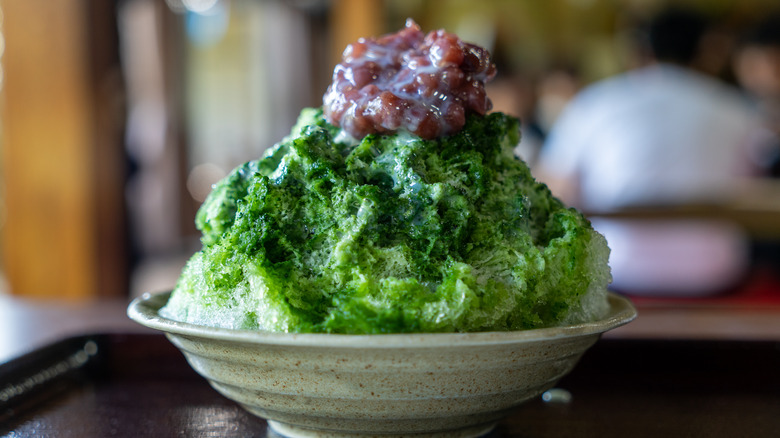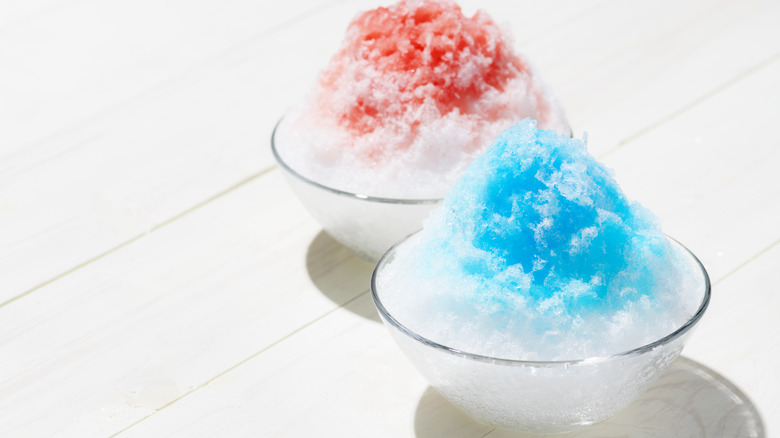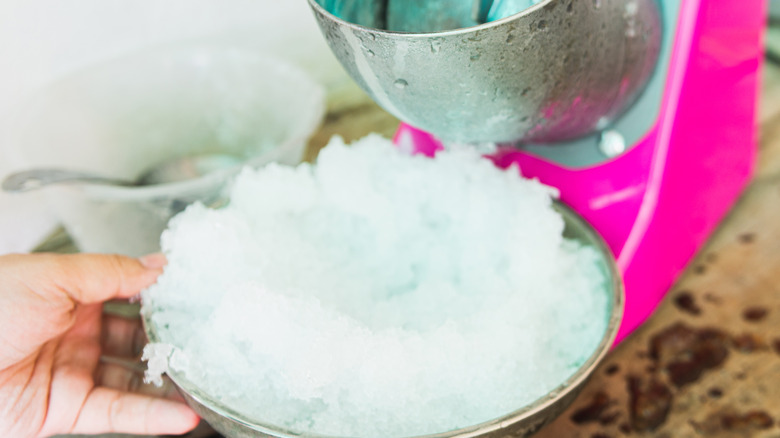What Makes Japanese Kakigori So Unique
We may receive a commission on purchases made from links.
If you're apathetic about dessert, the term "shave ice" might conjure images of industrial-grade dispensers churning engine-coolant-hued syrup over paper cones mounded with frozen slush. For many, the cool treat is synonymous with sidewalk carts parked outside of sporting events, stalls that attract museum-goers on hot summer days in the city, or Hawaiian beaches where one might spot former President Barack Obama tucking into a cherry and lemon-lime cone from Island Snow (his favorite snack on the archipelago, per the Los Angeles Times).
While the aforementioned treat is delicious, it's not shave ice; it's a snow cone. According to KitchenAid, there are several differences between the two oft-conflated refreshments. "Shave ice has a lighter, fluffier texture than crushed ice, which is commonly used for making snow cones," writes the brand. Ironically, the texture of shave ice is closer to snow than a snow cone, which has a distinctive crunch.
Today, shave ice goes by many names around the world. In the Philippines, it's called halo-halo, a sundae-like dessert that translates to "mix mix" in Tagalog, per Atlas Obscura. In Japan, the shave ice treat kakigori comes with elaborate mix-ins.
From artificial syrup to designer stawberries
Kakigori has made big waves in the United States in recent years. But the origin of the Japanese shave ice dessert long precedes its tenure in the Los Angeles pop-up scene. According to LAist, the dessert was first enjoyed by Japanese aristocrats nearly a thousand years ago, in the Heian period. It made its first appearance in Sei Shōnagon's 11th-century tome "The Pillow Book," a gossip-laden account of the author's time as court lady to Empress Consort Teishi, per Columbia University Press.
Billed by the Japanese travel guide Kyuhoshi as "soft, light and fluffy," kakigori typically comes topped with sweet syrups, fruit, and condensed milk or cream — although LAist notes that its earliest recipes simply called for crushed plums and honey. And as the dessert has grown in popularity, so too have its toppings. "In Japan, kakigori has evolved from a simple shaved ice treat relying on artificially-flavored and colored syrups to an artisan treat," writes LAist. Souped-up garnishes might include Oishii strawberries (those impossibly perfect-looking berries only sold in three U.S. states), high-end chocolate, and yuzu cheesecake.
Naoto Yonezawa — the founder of Japanese Kuramoto Ice USA, inc. who's credited with bringing the "modern kakigori" craze to the Golden State — convinced Japanese chefs in LA to fly in special ice from Japan and invest in decadent toppings. "Putting bottled syrups on Kuramoto's ice would be like dousing a wagyu steak with ketchup," writes LAist.
Kakigori at home
If you don't live near a kakigori purveyor but your mouth is watering with thoughts of delicate ice shavings sweetened with saccharine finery, you might consider making it at home. According to MasterClass, the secret to getting the melt-in-your-mouth ice is by using mineral water that's been "tempered" at room temperature to "remove its frosty sheen." That slightly flattened water will get frozen for three hours in the mold of a kakigori machine, which looks something like a Keurig. (If you don't have one of those, MasterClass suggests crushing eight ounces of mineral ice in a blender.)
Once your base is ready, all that's left to do is mix up the sweets, which in this recipe include high-quality matcha, sugar, sweetened condensed milk, and red bean paste. After mixing the dry ingredients together, whisk in a quarter cup of boiling water to create a thickened syrup. Let it come down to room temperature, chill it in the fridge, and use it to bedazzle your shave ice alongside your condensed milk, topping the whole thing with a dollop of red bean paste. Or, you can make like Naoto Yonezawa and go wild with the fancy toppings.


